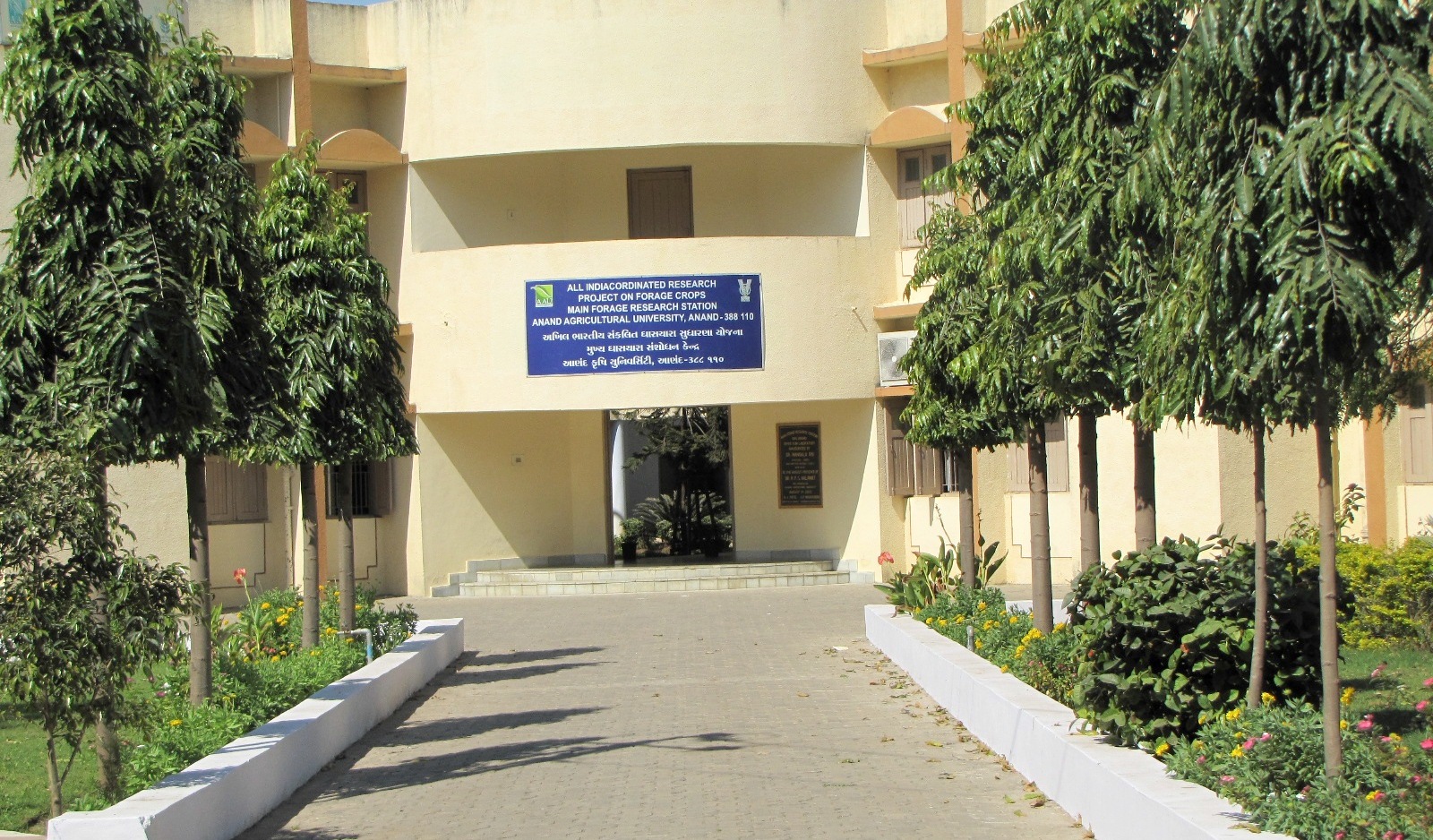Search
Unit Menu
Latest News
Main Forage Research Station, Anand
Main Forage Research Station

Main Forage Research Station
AICRP on Forage Crops & Utilization
ICAR Unit – 9, Anand Agricultural University
Anand – 388 110 (Gujarat), India
Phone: (O) 02692-264179
Email: forageanand@aau.in
Livestock is an important component of Indian rural and urban economies. However, the low productivity of livestock is a matter of concern, which is primarily due to insufficient fodder and feed resources. Concerted efforts are needed to augment the production of high yielding forage crops to enhance the productivity of animal wealth.
The cultivation of forage crops has gained importance in recent years due to rapid diminution of grassland and pasture areas. Growing forage crops as sole crop or in existing cropping systems, utilizing marginal and problematic soils is practiced to a varying degree throughout the country. This is especially true in tracts for dairy farming in Gujarat. Forage production has to be oriented in such a manner that there is a regular and continuous supply for a longer period. However, under rainfed conditions, availability of green forages is restricted only for three to four months in a year, owing to seasonal rainfall. Looking at the existing gap between the demand and supply, it is necessary to transfer the available technology of forage production to the farmer’s fields.
In Gujarat, the research work on grasses was initiated in 1963 under Grass Research Scheme at erstwhile Institute of Agriculture, Anand. Subsequently, Anand was identified as one of the centers of AICRP on Forage Crops by ICAR in 1970. For Strengthening Research in Forage Crops in the state, a plan project was sanctioned by GAU in 1986 at Anand. The work on rainfed grasses is being conducted at Grassland Research Station, Dhari. With these schemes and other projects on forage crops, subsequently the research centre has been recognized as a Main Forage Research Station of Anand Agricultural University since year 2004. Anand Agricultural University came into existence with effect from 01 May 2004 by enactment of Gujarat Agricultural Universities Act, 2004 (Gujarat Act, No.5 of 2004) with transfer of the activities of the Anand zone of the erstwhile Gujarat Agricultural University. The Main Forage Research Station, Anand Agricultural University, Anand is conducting the research work on cultivated forage crops under irrigated conditions with the objectives to breed and develop high yielding, disease and pest resistant and better quality varieties of different forage crops like sorghum, bajra, maize, lucerne and grasses to cater the needs of the different regions of the Gujarat state. In the context of technology transfer in forages, there has been relatively good progress in well-defined production systems and varietal improvement. The majority of the farmers under the existing production systems are yet to get the advantage of forage production technology. It is vital to provide knowledge about scientifically developed package of practices to the developmental workers and the other users for improvement in forage production. This station is located in main campus of the university, which is set on the Ahmedabad-Mumbai railway line, 65 km from Ahmedabad and 40 km from Vadodara railway stations and is linked by National Expressway-1 and National Highway-8. The Geographic coordinate of the AAU is 22.56 °N Latitude and 72.95 °E Longitude, and it is lies on 45 m above mean sea level. The AAU campus is of at 5-6 km distance from railway station as well as GSRTC bus stand. The mandates and brief salient achievement of this centre are given as below.
Mandates
1. To carry out an integrated multi-disciplinary and problem-oriented programme of forage research by a team of scientists including plant breeder, agronomist and biochemist (Quality evaluation).
2. To evolve high yielding varieties having high forage yield, disease and pest tolerant varieties / hybrids with better quality.
3. To generate information on forage technologies as well as multiply and supply the targeted breeder seeds requirements of the varieties developed by the project and national fodder varieties.
4. To breed high yielding varieties of forage crops having high forage yield and quality.
5. To develop forage crops varieties for moisture stress condition, alkalinity, saline conditions and resistant to water logging.
6. To develop and introduce legumes like stylosanthes, siratro for improving the carrying capacity of pasture lands.
7. To develop agro-techniques and package of practices for maximizing production of forage crops.
8. To collect, select and breed various indigenous grasses and legumes for different agro-climatic zones of the state with the ultimate aim to increase the production of grasses and legumes from the natural grasslands of the state and also to conduct Research in Grassland and management and development.
Salient Achievements
· Total 28 varieties have been released click here
· Total 81 technologies are developed click here
· About 1018 germplasms of various nine crops are maintained at this center click here
· There are 4 long-term Project/Scheme in operation at this center click here
· Total 9 Project/Scheme are completed successfully click here
· Total 62 research papers published in international and 102 in national journals click here

